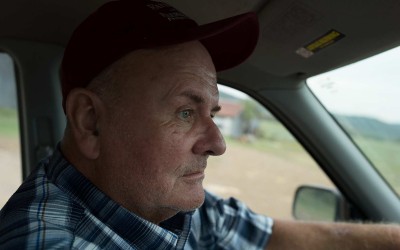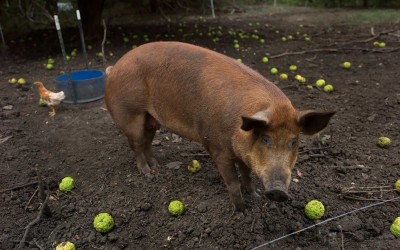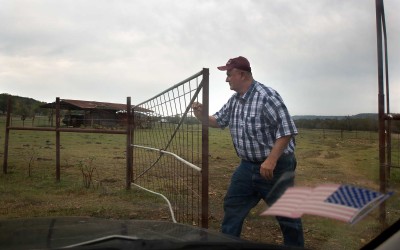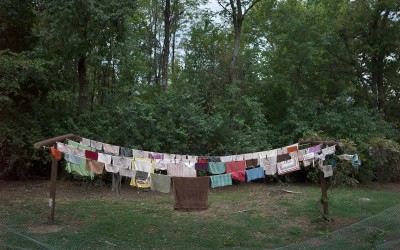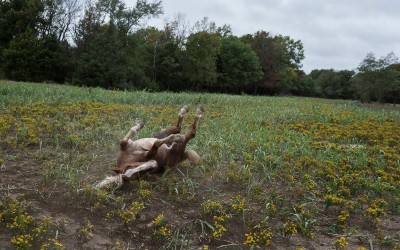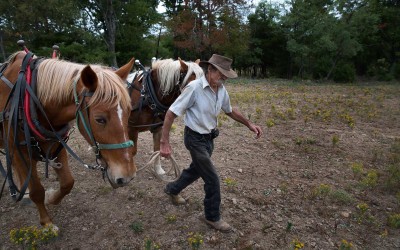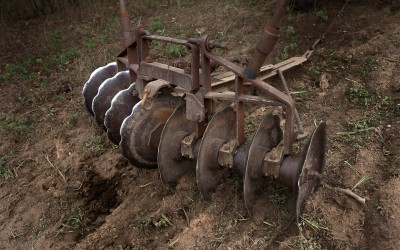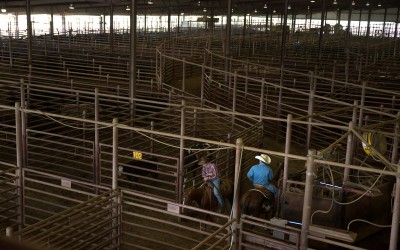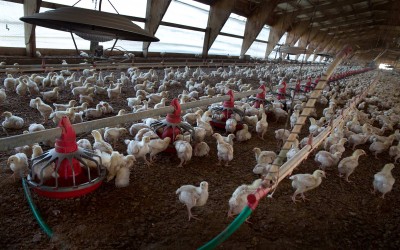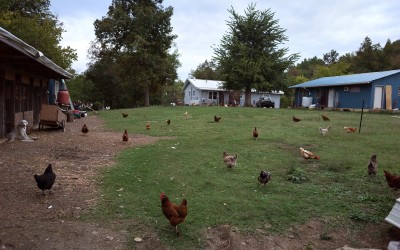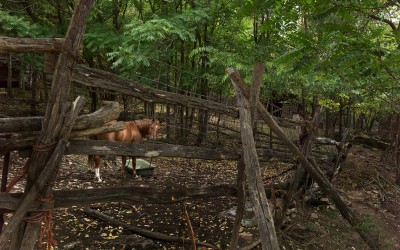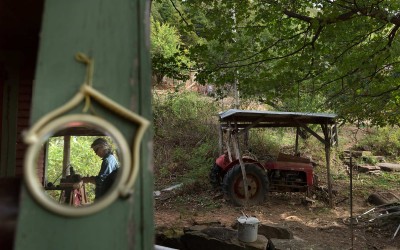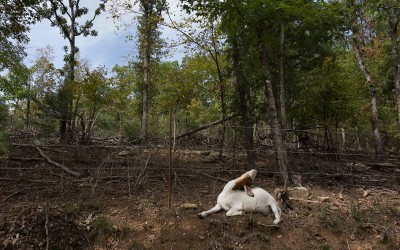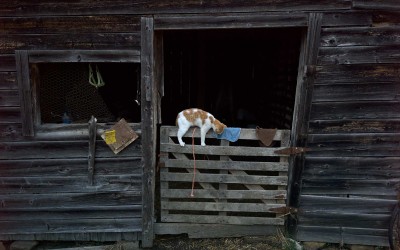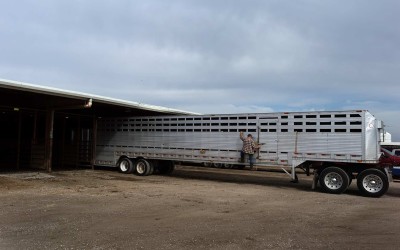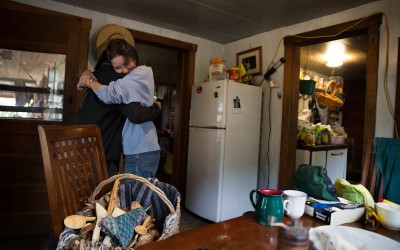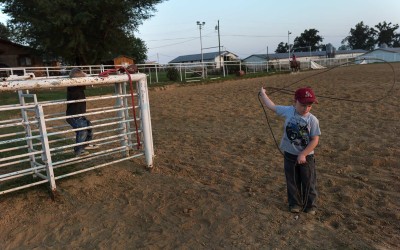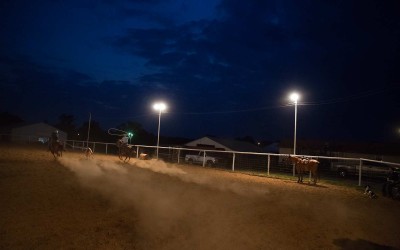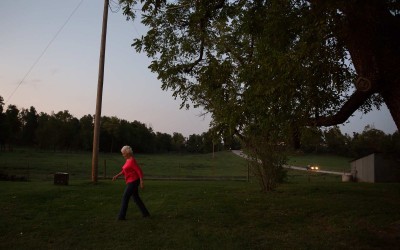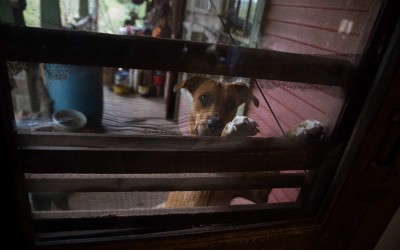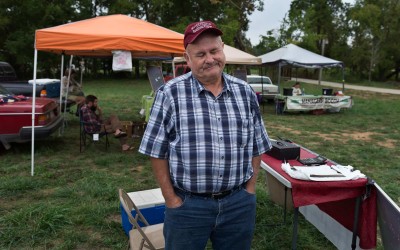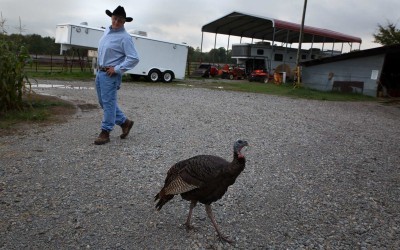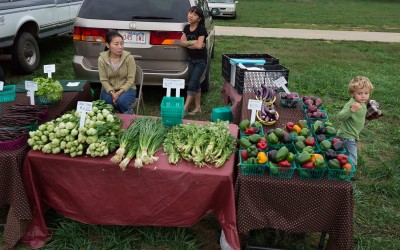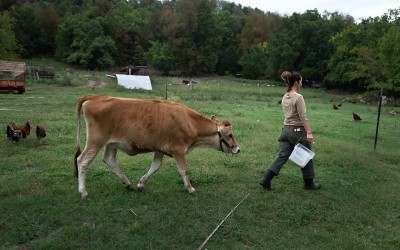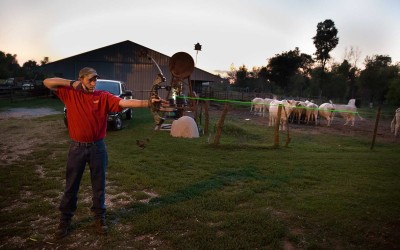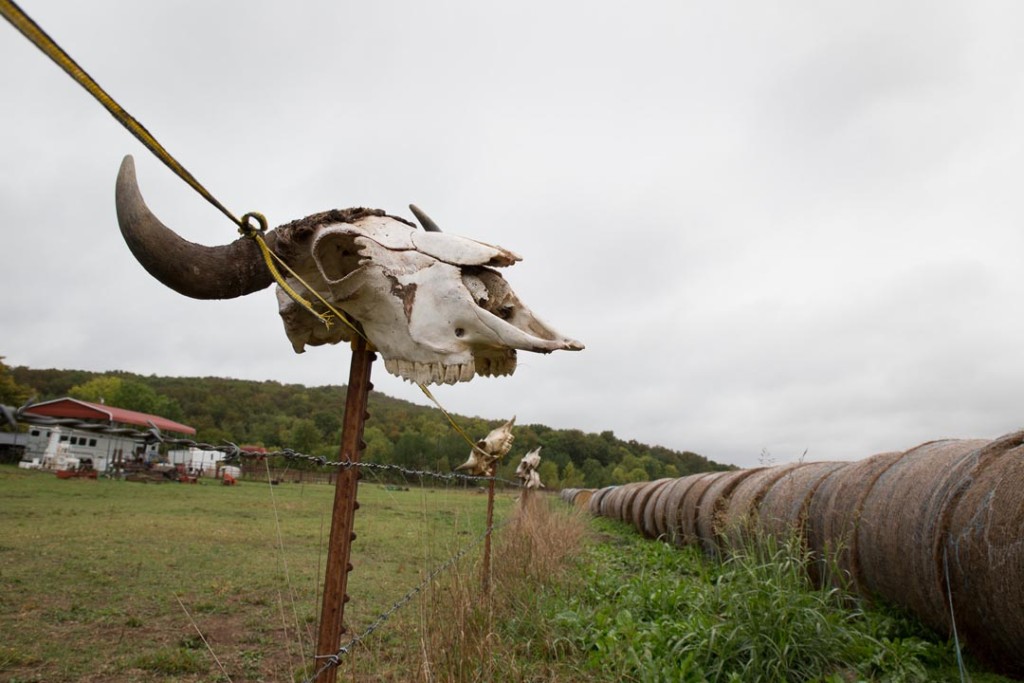Elkins, Arkansas: High feed costs as well as demand for grass-fed beef led Alan Shumate to quit finishing his cattle on corn. On the heels of the drought, he is heading into winter with one-third his expected hay crop and one-half his pasture. “I’m gonna pregnancy check all my females, anything that’s been with a bull—if they’re not pregnant, why, I don’t need to winter ’em.” He will sell some of his herd. “That’s not necessarily a product of the drought, that’s doing the business right.”
Elkins, Arkansas High feed costs as well as demand for grass-fed beef led Alan Shumate to quit finishing his cattle on corn. On the heels of the drought, he is heading into winter with one-third his expected hay crop and one-half his pasture. “I’m gonna pregnancy check all my females, anything that’s been with a bull—if they’re not pregnant, why, I don’t need to winter ’em.” He will sell some of his herd. “That’s not necessarily a product of the drought, that’s doing the business right.”
Fayetteville, Arkansas: Ellie under an Osage orange tree. “She’s such a good mama,” Mariah White says of the sow. “She loves belly rubs.” Mariah seeks Animal Welfare Approved slaughterhouses to process her pork. “Eating meat is a real gift, and it’s good to be as conscious as possible. I don’t take it that lightly. When we go to the butcher, I cry. When we load up our pigs on the trailer, I cry.”
Fayetteville, Arkansas Ellie under an Osage orange tree. “She’s such a good mama,” Mariah White says of the sow. “She loves belly rubs.” Mariah seeks Animal Welfare Approved slaughterhouses to process her pork. “Eating meat is a real gift, and it’s good to be as conscious as possible. I don’t take it that lightly. When we go to the butcher, I cry. When we load up our pigs on the trailer, I cry.”
Elkins, Arkansas: “You’ve gotta be an optimist to be in the cattle business,” Alan Shumate says. “If you don’t love it, it’s not profitable enough to spend the time.” Aside from raising grass-fed beef, he works full-time as a truck dispatcher at a turkey-processing plant and cuts and sells hay.
Elkins, Arkansas “You’ve gotta be an optimist to be in the cattle business,” Alan Shumate says. “If you don’t love it, it’s not profitable enough to spend the time.” Aside from raising grass-fed beef, he works full-time as a truck dispatcher at a turkey-processing plant and cuts and sells hay.
Fayetteville, Arkansas: Northwest Arkansas is suffering a two-year-old drought; with little chance of rain, Mariah and Ira White’s clothes dry outside. The couple’s small farm supplements his income from carpentry work, and helps feed their family.
Fayetteville, Arkansas Northwest Arkansas is suffering a two-year-old drought; with little chance of rain, Mariah and Ira White’s clothes dry outside. The couple’s small farm supplements his income from carpentry work, and helps feed their family.
Madison County, Arkansas: Fields on top of Pinnacle Mountain, where the author’s family once grew tomato and sweet potato crops, now produce grass for horses.
Madison County, Arkansas: Fields on top of Pinnacle Mountain, where the author’s family once grew tomato and sweet potato crops, now produce grass for horses.
Madison County, Arkansas: Richard Courteau uses his neighbor’s old, experienced mare, left, to train her green partner to work in harness.
Madison County, Arkansas: Richard Courteau uses his neighbor’s old, experienced mare, left, to train her green partner to work in harness.
Madison County, Arkansas: A horse-drawn disk harrow on the Courteaus’ farm prepares a field to be sown with winter rye grass.
Madison County, Arkansas: A horse-drawn disk harrow on the Courteaus’ farm prepares a field to be sown with winter rye grass.
Joplin, Missouri: Missouri’s Joplin Regional Stockyards is the largest cow and calf auction in the nation, capable of processing 10,000 cattle a day. Much of the livestock comes from Arkansas, as well as from farms and ranches in Missouri, Oklahoma, and more distant states.
Joplin, Missouri: Missouri’s Joplin Regional Stockyards is the largest cow and calf auction in the nation, capable of processing 10,000 cattle a day. Much of the livestock comes from Arkansas, as well as from farms and ranches in Missouri, Oklahoma, and more distant states.
Springdale, Arkansas: Marlene and Virgil Moore, like many farmers in Arkansas, raise chickens for major poultry processors to supplement their income. Companies such as Tyson’s are among the state’s largest employers.
Springdale, Arkansas: Marlene and Virgil Moore, like many farmers in Arkansas, raise chickens for major poultry processors to supplement their income. Companies such as Tyson’s are among the state’s largest employers.
Fayetteville, Arkansas: The Whites can’t keep up with demand for their free-range chickens. The farm is a little over breaking even. “I came from a back-to-the-land family,” Ira says, and while several friends who share his background left for cities, many have returned home, “wanting to have that connection to the land, to nature.”
Fayetteville, Arkansas: The Whites can’t keep up with demand for their free-range chickens. The farm is a little over breaking even. “I came from a back-to-the-land family,” Ira says, and while several friends who share his background left for cities, many have returned home, “wanting to have that connection to the land, to nature.”
Madison County, Arkansas: The author’s father, Richard Courteau, received this gelding as gift. Currently, no one rides him.
Madison County, Arkansas: The author’s father, Richard Courteau, received this gelding as gift. Currently, no one rides him.
Madison County, Arkansas: Maeve Courteau, sands a wooden spoon on her porch. “What inspired me was a piece of firewood that was too beautiful to burn,” she remembers of her first effort, carved of spalted maple in 1984. “It was kind of discouraging because it was rough and crude and I didn’t have the right tools.” She still has the spoon, but only began carving “earnestly” and selling spoons at the Fayetteville Farmer’s Market in 1997.
Madison County, Arkansas: Maeve Courteau, sands a wooden spoon on her porch. “What inspired me was a piece of firewood that was too beautiful to burn,” she remembers of her first effort, carved of spalted maple in 1984. “It was kind of discouraging because it was rough and crude and I didn’t have the right tools.” She still has the spoon, but only began carving “earnestly” and selling spoons at the Fayetteville Farmer’s Market in 1997.
Madison County, Arkansas: Goats can still be found walking on a dirt road in deeply rural Madison County. Local deputy sheriff Captain Robert Boyd admits he fields calls about goats and chickens trespassing in neighbors’ yards.
Madison County, Arkansas: Goats can still be found walking on a dirt road in deeply rural Madison County. Local deputy sheriff Captain Robert Boyd admits he fields calls about goats and chickens trespassing in neighbors’ yards.
Madison County, Arkansas: Neighbors of the Whites say their place was once farmed with mules. The Whites built most structures on the property since they bought it two years ago, but kept this shed, previously a kennel for hunting hounds. Inside, Ira milks a cow as a cat plays on the gate.
Madison County, Arkansas: Neighbors of the Whites say their place was once farmed with mules. The Whites built most structures on the property since they bought it two years ago, but kept this shed, previously a kennel for hunting hounds. Inside, Ira milks a cow as a cat plays on the gate.
Joplin, Missouri: A rancher climbs on his truck to shoo cattle into the Joplin Stockyards for sale. Some cattle are now auctioned online, an arrangement used mainly for larger herds. But for so many small cattle farms in the area, the stockyards are a necessity.
Joplin, Missouri: A rancher climbs on his truck to shoo cattle into the Joplin Stockyards for sale. Some cattle are now auctioned online, an arrangement used mainly for larger herds. But for so many small cattle farms in the area, the stockyards are a necessity.
Madison County, Arkansas: Darcy Courteau and her father hug before he leaves to work the upper pastures of his property with horses.Madison County, Arkansas: Darcy Courteau and her father hug before he leaves to work the upper pastures of his property with horses.
Madison County, Arkansas: Darcy Courteau and her father hug before he leaves to work the upper pastures of his property with horses.Madison County, Arkansas: Darcy Courteau and her father hug before he leaves to work the upper pastures of his property with horses.
Springdale, Arkansas: Marlene and Virgil Moore keep a roping arena at their Springdale home. A child practices his cowboying skills.
Springdale, Arkansas: Marlene and Virgil Moore keep a roping arena at their Springdale home. A child practices his cowboying skills.
Springdale, Arkansas: Friends and neighbors stop by the Moores’ arena with their horses to practice riding and steer roping.
Springdale, Arkansas: Friends and neighbors stop by the Moores’ arena with their horses to practice riding and steer roping.
Springdale, Arkansas: Karleen King rents her pasture to friend and neighbor Tom Stamps, who keeps cattle on the land. As the sun sets, Karleen finishes filling a water tank for the cattle.
Springdale, Arkansas: Karleen King rents her pasture to friend and neighbor Tom Stamps, who keeps cattle on the land. As the sun sets, Karleen finishes filling a water tank for the cattle.
Madison County, Arkansas: Maeve Courteau’s dog, Annie, smells breakfast and hopes to be let inside.
Madison County, Arkansas: Maeve Courteau’s dog, Annie, smells breakfast and hopes to be let inside.
Elkins, Arkansas: High feed costs as well as demand for grass-fed beef led Alan Shumate to quit finishing his cattle on corn. On the heels of the drought, he is heading into winter with one-third his expected hay crop and one-half his pasture. “I’m gonna pregnancy check all my females, anything that’s been with a bull—if they’re not pregnant, why, I don’t need to winter ’em.” He will sell some of his herd. “That’s not necessarily a product of the drought, that’s doing the business right.”
Elkins, Arkansas: High feed costs as well as demand for grass-fed beef led Alan Shumate to quit finishing his cattle on corn. On the heels of the drought, he is heading into winter with one-third his expected hay crop and one-half his pasture. “I’m gonna pregnancy check all my females, anything that’s been with a bull—if they’re not pregnant, why, I don’t need to winter ’em.” He will sell some of his herd. “That’s not necessarily a product of the drought, that’s doing the business right.”
Elkins, Arkansas: Orthodontist and bison rancher Tom Lowder rescued two wild turkey eggs from an abandoned nest on his property. Once the turkeys hatched, they opted to stay on his place.
Elkins, Arkansas: Orthodontist and bison rancher Tom Lowder rescued two wild turkey eggs from an abandoned nest on his property. Once the turkeys hatched, they opted to stay on his place.
Fayetteville, Arkansas: A large community Hmong farmers, originally from Laos, have recently settled in the area from other parts of the United States and now make up the bulk of vegetable vendors at local markets. Many grow produce varieties familiar to American palates as well as chilies, green Thai eggplants, and pumpkins for Southeast Asian recipes. One farmer, Vab Yang, substitutes cucumber for difficult-to-find green papaya in her salads.
Fayetteville, Arkansas: A large community Hmong farmers, originally from Laos, have recently settled in the area from other parts of the United States and now make up the bulk of vegetable vendors at local markets. Many grow produce varieties familiar to American palates as well as chilies, green Thai eggplants, and pumpkins for Southeast Asian recipes. One farmer, Vab Yang, substitutes cucumber for difficult-to-find green papaya in her salads.
Fayetteville, Arkansas: Mariah White is followed by Scarlett, the jersey cow kept to produce milk for the household. The family makes some of the milk into butter and ricotta cheese.
Fayetteville, Arkansas: Mariah White is followed by Scarlett, the jersey cow kept to produce milk for the household. The family makes some of the milk into butter and ricotta cheese.
Springdale, Arkansas: Tom Stamps hits a target outside Karleen’s barn. During deer bowhunting season, Tom hunts in the evenings, after leaving work at plastic bag factory Glad. A small light affixed to the end of each arrow helps him spot it once it’s been shot.
Springdale, Arkansas: Tom Stamps hits a target outside Karleen’s barn. During deer bowhunting season, Tom hunts in the evenings, after leaving work at plastic bag factory Glad. A small light affixed to the end of each arrow helps him spot it once it’s been shot.
LAND BOUND IN THE OZARKS
Photography by Lucian Perkins / Written by Darcy Courteau
Delbert Bolinger was operating a road grader for the city of Fayetteville, Arkansas, smoothing its outer dirt streets some twenty years ago when a family in town invited him in. They all had blood on their feet. “I guess you butchered you a hog,” he told them as he helped himself into the house.“You were nosy,” BettyJo Disney decided, reminiscing with Delbert as they sat on her screened-in porch, drinking iced tea. Best friends, they are both in their seventies now. BettyJo likes Delbert, she said, because he’s country. He grew up cutting hay with a horse-drawn rake before he ever used a tractor.
Delbert and BettyJo hardly knew me, but I was their neighbors’ daughter, they loved my mother, and I was trying to write a story, which meant I had a miniature dream of some independent thing I wanted to do, and that was something they—like so many people in the area—understood well. They wanted to help.
Cattle grazed outside.
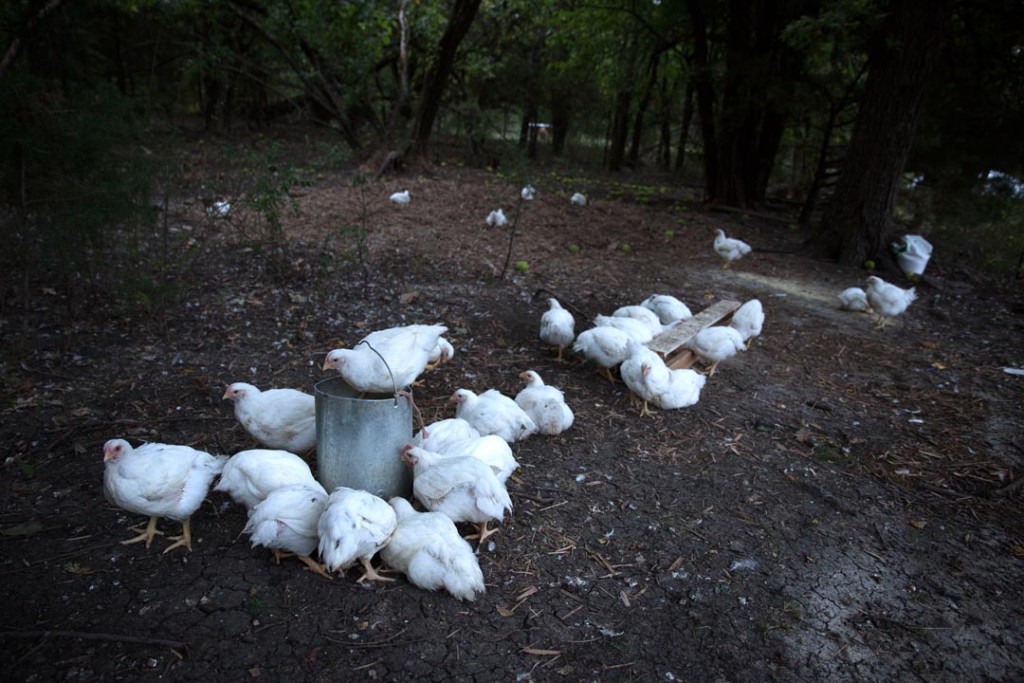
Fayetteville, Arkansas: As the sun sets, the Whites free-range chickens enjoy dinner. The Whites can’t keep up with demand for their free-range chickens. The farm is a little over breaking even. “I came from a back-to-the-land family,” Ira says, and while several friends who share his background left for cities, many have returned home, “wanting to have that connection to the land, to nature.”
Yes, Delbert admitted, he was nosy, and it had gotten him in trouble. The family had killed and cooked up not a tender pig but a goat, and someone in the house handed him a forkful of the stringy meat.
“I take a bite of that thing,” he remembered, “and the more I chewed, the bigger it got. I thought, How am I gonna get rid of this? Only one way to do it. I swallered it. About choked.”
Swallered. He seemed to take pleasure in the word, drawing out its clay-mudded second half before continuing. They asked how he was doing. “I said, ‘Oh, I got a crick in my neck,’ and this old lady, she stepped behind me. I didn’t think about it, and she hit me right there on the back, and her hand was cold as ice. And I said, ‘Well, my neck’s better,’ and she said”—Delbert took a breath—“‘Praise. God.’ And I thought, What? And I got back out there on the grader and I thought, this couldn’t be right, you can’t—”
“Heal somebody with a cold hand?” BettyJo offered.
“She prayed for me or something.”
Delbert told the story with Marco Polo-ish wonderment, glancing at me from the corner of his eye, making sure I was taking all this in. The witchcraft of the natives. The things they considered food, offering it to unwitting travelers, and all you could do was swaller.
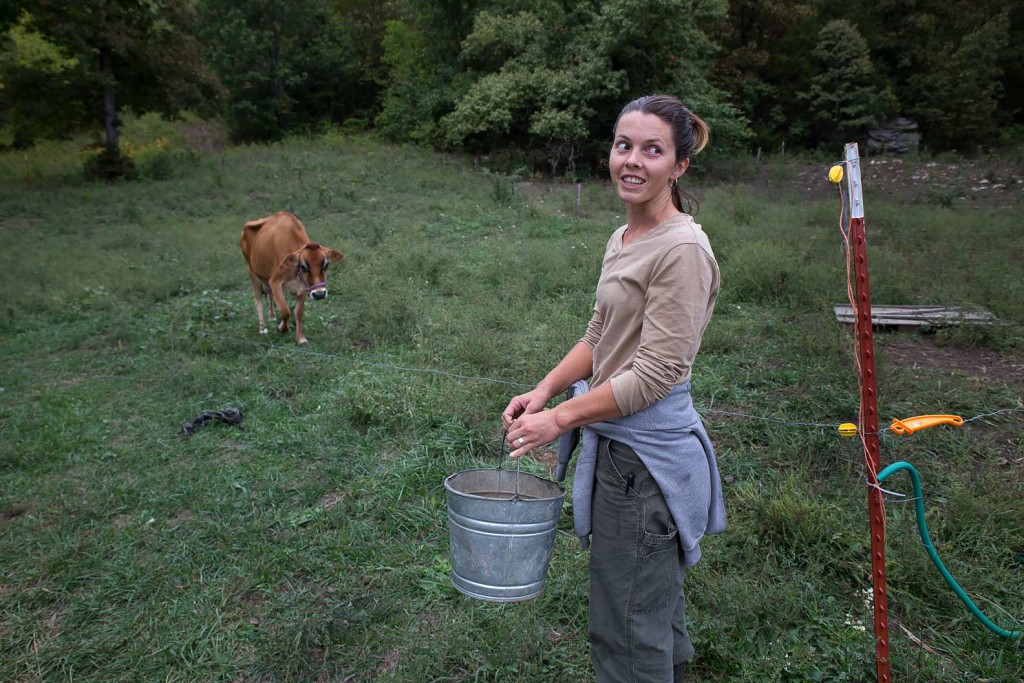
Fayetteville, Arkansas: Mariah White and her cow, Scarlett. The Whites can’t keep up with demand for their free-range chickens. The farm is a little over breaking even. “I came from a back-to-the-land family,” Ira says, and while several friends who share his background left for cities, many have returned home, “wanting to have that connection to the land, to nature.”
This was the final day of a trip last October that began with the feat, performed each visit home, of relearning the way from the newish Northwest Arkansas Regional Airport. The route is now an obstacle course of housing developments and chain stores, industry having transformed the landscape near the farm where I was born and grew up. Two adjacent counties, Benton and Washington, are home to the headquarters of Tyson Foods, trucking company J.B. Hunt, and, of course, Walmart. Clustered around the discount retailer are roughly 1,250 of its suppliers—Procter & Gamble, Rubbermaid, Glad—marketing, manufacturing, or distributing thousands of products, a great number of them aiding in personal hygiene and food storage.
Although income inequality in Arkansas has widened starkly since the 1970s, the unemployment rate in the northwest region is lower than elsewhere in the state, and lower than in the rest of the South. In the 1940s and ’50s, Delbert’s parents would leave his grandma and older siblings to tend their milk cows in nearby Madison County, taking Delbert with them to pick apples in the orchards of Washington State. There, they worked alongside other cash-strapped folk from Arkansas, Oklahoma, and Texas who made the seasonal trek, arriving in late summer and harvesting through fall.
Now total employment in Benton and Washington counties has almost tripled since 1980. People come here for work. Some even come for the kind of employment that lands them in huge suburban homes overlooking cattle pastures. In one Ozark farmstead after another, however, people—even those who have city jobs—still dream of having a self-sufficient, rural lifestyle.
The trees had begun to change color. Soon wood stoves would puff threads of smoke from the hills’ canopy: hickory, oak, maple, sumac, dogwood, redbud, paw-paw, sassafras, and persimmon.
The Ozark mountains—actually, not mountains at all, but the sturdier remains of a plateau eroded into a corrugation of hills—have gathered multi-generation farmers and hippie newcomers alike, all eventually marked with the land’s cussedness. After rains, the red clay pokes up arrowheads once chipped by the Osage Indians, who concentrated agriculture in the lowlands and hunted in the Ozarks. The soil is full of rocks. Later, settlers pulled those rocks from hollers and fashioned them into fences and church houses—some are still standing now—but their plows continued to churn up stones.
“He had his little farm, he had the hogs and doing what he could do, but he made his living dragging logs out of the woods with a mule.”
Her husband, Ira, 31, works as a carpenter. His car arrived at the gate, an electrified wire strung with Tibetan prayer flags. He stepped out, and for a moment Mariah relaxed. After some almost invisible communication between the two, Ira went to milk their single cow. In an unlighted shed, he baited the food trough with grain, and once the cow bounded in, he disinfected her nipples and lubricated them with coconut oil.
Neighbors say this shed was once a kennel for hunting dogs.
Milk jetted into the pail below.
A cat positioned itself in the straw.
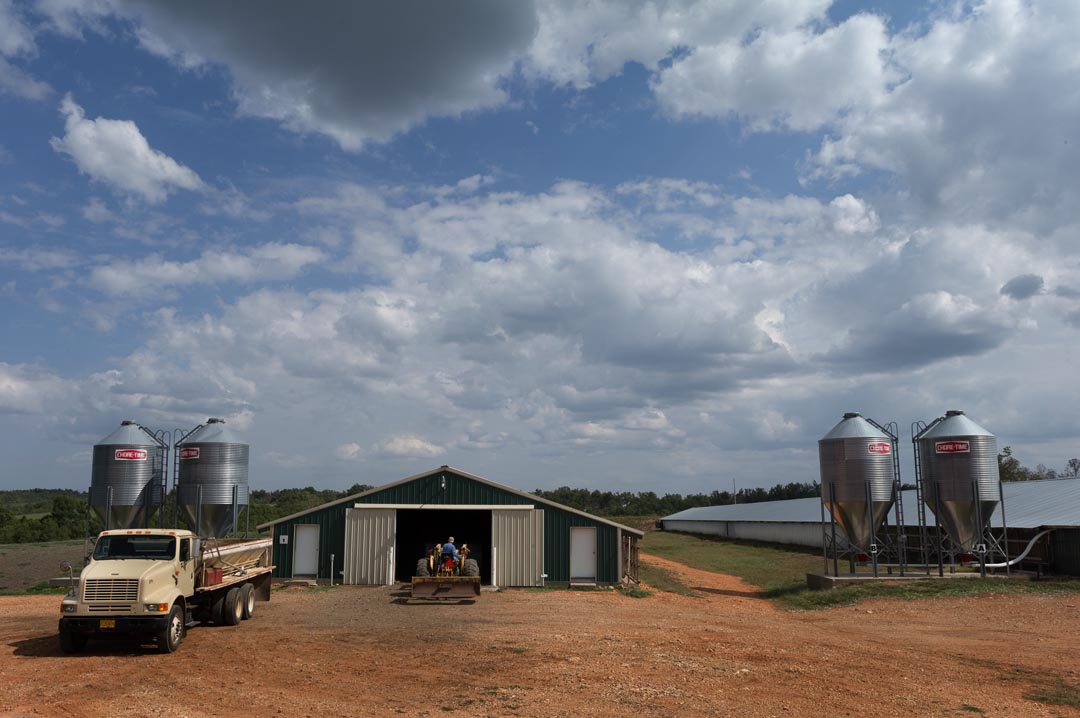
Without other income, George figures, true subsistence farming means no electricity, and him driving a team of mules, harvesting just enough corn to feed them and his family. Frankly, he doesn’t want to go back to that. He’d love to have a little truck-patch farm if he could afford to. But he knows how that goes. “My mom’s dad always tried to do the subsistence farming. He had a few hogs, raised a little bit of cotton.” By the 1960s, his grandfather had started working in the woods of eastern Arkansas, where the cypresses along the river bottoms were being cleared for farmland. “He had his little farm, he had the hogs and doing what he could do, but he made his living dragging logs out of the woods with a mule.”
His teenage daughter and son belong to FFA, the agriculture education organization formerly known as Future Farmers of America. They led into the yard their project animals, two fat, shining goats.
George knows what people think: This kind of operation he has now is against nature. So be it. Slight and spectacled, there’s none of the sunburnt farmer about him. He has a degree in poultry science, and he can genially track the uptick in the U.S. population along with its declining number of farmers. The tractors, the silos—there’s no other way: “There’s so few of us left, even if I could feed my family and five more, there’s way too many of you.”
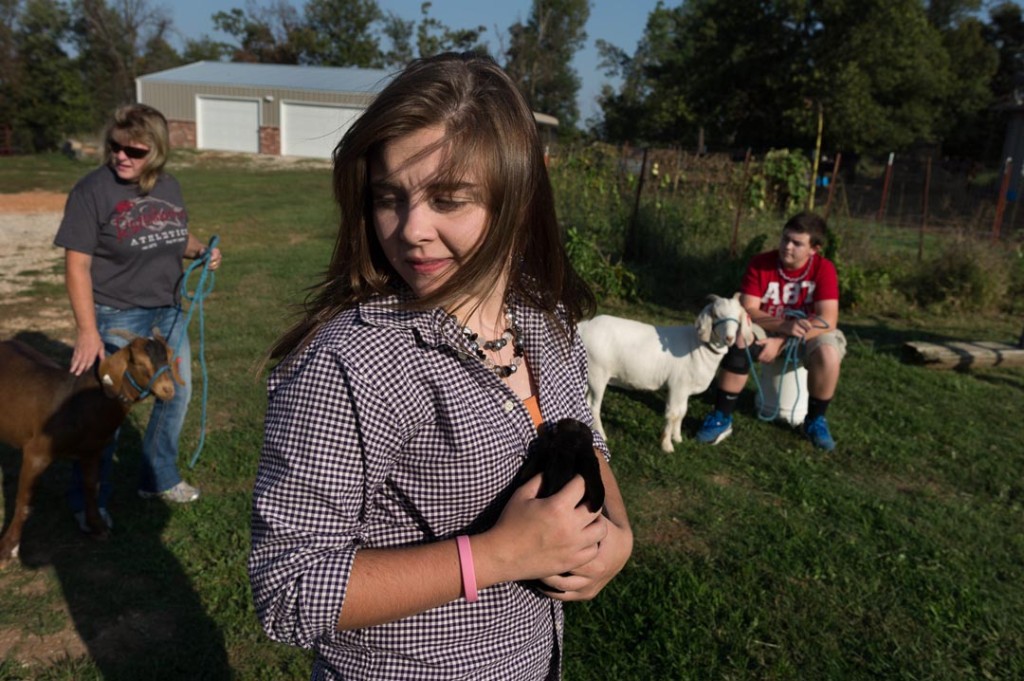
Lowell, Arkansas: Darla Anderson with her children, Meghan, 18, and Ben, 14, and their project animals, two goats and a rabbit. Meghan is president of her school’s Future Farmers of America program and Ben is also a member.
The goats bleated insistently, like shuddering machines.
Darla held on to one of them while her daughter fetched another project, a rabbit.
Darla and George will send the children to college, paying for it with chicken. The children will have better economic opportunities working with him, George said, but they can go on to careers in town, if they want.
He seemed doubtful they will. He’ll certainly never go back to the jobs he’s left. He couldn’t make it as an employee in the poultry industry, in which high-paying jobs are few. “I didn’t have the right presentation,” he said.
“He didn’t play the game,” Darla called over her goat.
“I couldn’t play the game.”
Do the Ozarks even make good employees? Living so far out, you get used to working on your own. J.B. Hunt, Walmart—family members have worked in both places. Walmart is a job, but it isn’t a dream. No, Walmart is where the boss says something you can’t swaller, and you give your notice and then just leave, crying in the parking lot and digging in your purse for cigarettes.
But if you leave the hills, migrate to a real city? Eventually, long after you’ve kicked the manure off your boots, you’ll give your country self away. One night your friend’s registered poodle will jump in your lap, and looking into his eyes, you’ll silently muse on the effects of your pastoral upbringing, how your attitude toward animals will forever be at once empathetic and callous because of some kind of shared fate you once had. You’ll keep these thoughts to yourself until your friend wonders aloud if she should have the dog neutered, and will let slip how much her mother paid for him. And you’ll yelp, “No—put him out to stud! Don’t cut off his testicles—those are worth 400 bucks apiece!”
So maybe you decide to stay, and stay country, even if that means having an industrial farm and a backyard garden, as George and Darla do, or hanging on to a job in town and coming home to feed cattle. The average Arkansas cattle herd is small, 30 head. Every other farmlet has one. The man who sells hay to my father also works as a truck dispatcher for a turkey processor, and on weekends sells grass-fed beef at the farmers’ market, next to Mariah. Even George keeps some cattle. When he has to move them from time to time, he rounds them up on a horse.
ABOVE
Lowell, Arkansas: George and Darla Anderson grow 15 million pounds of chicken each year for a poultry processor.
MADISON COUNTY, ARKANSAS
Dr. Tom neither castrates his bulls nor vaccinates the herd, and feeds them no hormones nor antibiotics, which would contaminate their meat. He prefers to let the bison build up natural resistance to infections.
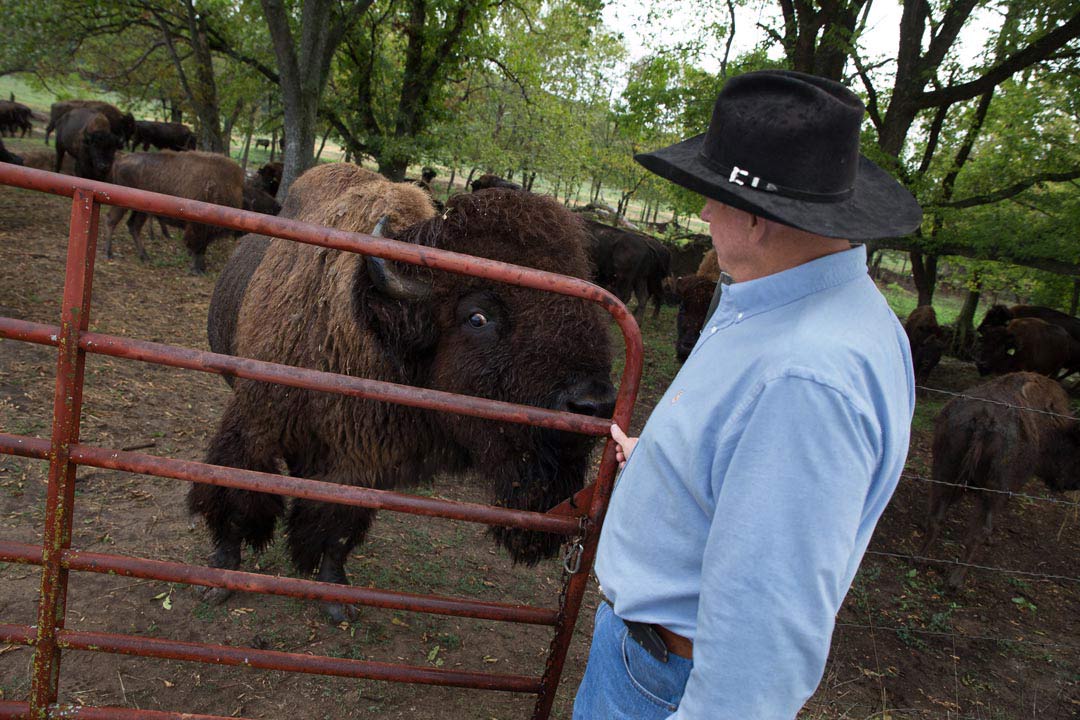
My father has known Dr. Tom for years, since they met in the local grocery store once outfitted with tables and chairs for old-timers to sit and drink coffee. Dr. Tom apparently concluded that he’d encountered an authentic article, a genuine antique horseman. Today, when my father joined Dr. Tom in the cabin, Dad wore an oilskin duster and a Western-print shirt, as if not to disappoint his friend.
A rain that my father, afraid of getting his hopes up, had dismissed as a squall the night before had turned into the steady pour the ponds and pastures needed.
Thunder cracked in the trees above.
Walnuts fell on the roof.
Dr. Tom neither castrates his bulls nor vaccinates the herd, and feeds them no hormones nor antibiotics, which would contaminate their meat. He prefers to let the bison build up natural resistance to infections. Still, living free range is tough on the animals. Some die. He leaves the carcasses to the animals he reported seeing on the property: coyotes, bobcats, cougars, black bears. Then he collects the skulls, sets them on fence posts, and lets them bleach in the sun.
Like Delbert and BettyJo, Dr. Tom and my father were anxious to provide useful quotes. The rancher was explaining the health benefits of his animals’ meat, so much better for you than feed-lot beef, but don’t get him wrong, “our beef industry, like our poultry industry, feeds the world, and so they have to do things that they have to do to mass-produce; that is OK with me, but I like to have a choice”—when Dad redirected the conversation.
“Tom, your being in buffalo, does it possibly have anything to do with the fact that you, kind of like me myself, are a bit of a romantic?”
“Absolutely. Absolutely,” the rancher conceded. “It throws you back.” Dr. Tom calls his place Wounded Knee Ranch. In 1968, he could only afford to continue studying dentistry at an underserved hospital on the Sioux Indians’ Rosebud reservation in South Dakota. There, he spent time with Henry Crow Dog, a shaman in a line of famous medicine men. To the young intern, some of the American Indian practices seemed directly in line with the Christian Bible.
Dr. Tom now wondered about the antioxidant properties of plants growing in the Garden of Eden, if they were like the plants ancient Indians gathered. In any case, the Indians’ diet must have been better than ours, he decided, citing as evidence a dentist’s early 1900s research on indigenous peoples who never ate refined foods. “It’s interesting to see the earliest photographs taken of these absolutely gorgeous faces,” he said, “wide faces, broad dental arches shaped beautifully.”
“If we use the wisdom God gave us, we can go out and collect plants and purify,” Dr. Tom imagined. “We won’t extend our lives beyond what he’s set the limit on to any great degree, but we’ll have healthy lives.” He and my irreligious father, now enthralled, talked about the storied Sioux who lived through Wounded Knee, eating lean, crimson bison meat, dying old.
The rain let up, and we walked outside.
In the yard were two wild turkeys, a brother and sister. A friend of our host had found an abandoned nest and incubated the eggs. The tom followed us around.
Along a fence was a line of horned skulls, each bobbling on a fence post: white, white, white, white.
Dr. Tom opened a gate to the bison’s pasture.
The bulls’ faces were covered in cockleburs, and they roared like lions.
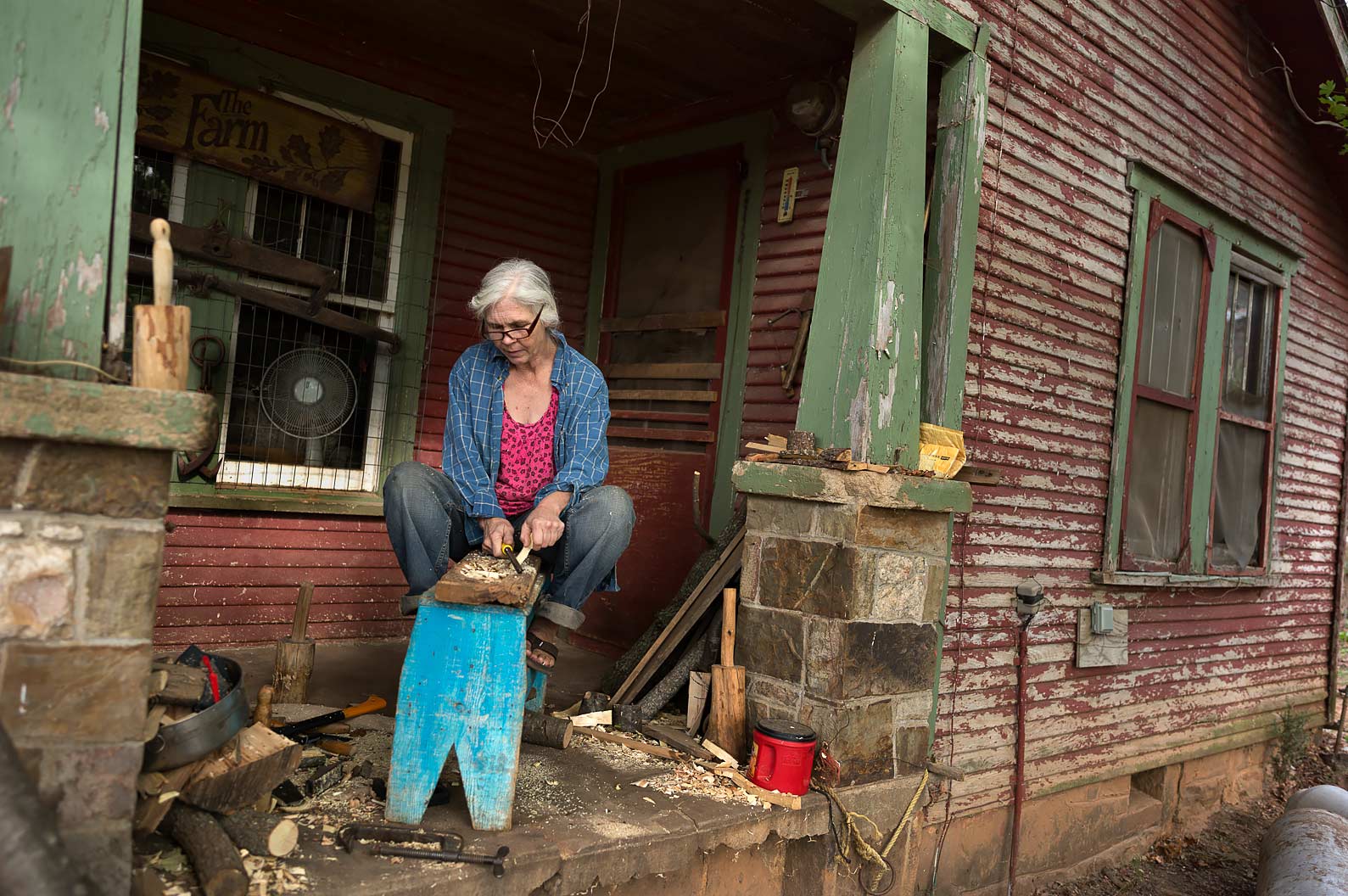
She walks into the forest with a handsaw when she spots a straight persimmon, or a fallen branch of cherry, whose red heartwood makes the prettiest spoons.
A child prodigy and an Army brat, she grew up, according to her family’s lore, with a sketchbook in her hand and her fingers stained with charcoal. She went to Ireland to paint and find adventure in her late teens, and then came back to her family in the Ozarks. She got factory jobs, catching tortillas in stacks of a dozen at a Mexican Original plant, and gutting chickens for Campbell’s Soup. She’d work for months at a time, save her money, and then quit to drift and draw. When she was 21, she met my father, and—not tragically, at least not for her children—diverted most of her creativity into raising us, seven eventually.
She would often quote a verse to us, from Matthew: And why take ye thought for raiment? Consider the lilies of the field, how they grow; they toil not, neither do they spin.
Now, the house’s paint is peeling. With no working cook stove, my mother fixes collards and curries on a hotplate. Packrats have moved in. From time to time, she texts me updates on the number of them she’s caught and released away from the house. Her latest triumph came illustrated with a digital rat: –,@,¥
After six decades of terrific health, delivering some of her babies without medical insurance, she isn’t feeling well. Her illness is not life threatening—surgery is optional—so there was only one doctor’s visit. This is the price of freedom, she says. She will eat better, rest, and heal herself.
Praise God.
One afternoon I followed the limestone path through the front yard toward the house. When my sister Sarah and I were preschool age, our mother had spent a day sewing us new dresses, orange calico for Sarah, navy for me. We’d waited for her to finish them, and pulled the dresses over our bare chests, and this was where we’d run outside to dance in our new finery, spinning the skirts in circles.
On the porch were horse tack, dog food bowls, a barrel of drinking water. In one corner was a stack of cathode-ray television sets, gifts from friends who thought that my mother and father could use all the material help they could get. Also, they’d moved on to flat screens. But my parents planned to listen to the presidential debates on the radio.
How hard a person must work to keep up with the times! And how much devotion it requires not to do so.
I tiptoed up the steps.
Through a screen door, I saw my mother sleeping in a chair near the wood stove, in the same room where she’d given birth to me. I’d brought her a new, scholarly biography of St. Francis of Assisi, which she read in an afternoon and, deciding to give it to a friend, immediately began rereading favorite passages, preparing to part with the book. It was open on her lap.
A floor lamp lit my mother’s waist-length braid white, white.
All around her the trees’ leaves were turning color, as if by witchcraft.
She kept sleeping.
Mother, mother.
Why do you still let us dream all these dreams?
ABOVE
Madison County, Arkansas: Maeve Courteau, sands a wooden spoon on her porch. “What inspired me was a piece of firewood that was too beautiful to burn,” she remembers of her first effort, carved of spalted maple in 1984. “It was kind of discouraging because it was rough and crude and I didn’t have the right tools.” She still has the spoon, but only began carving “earnestly” and selling spoons at the Fayetteville Farmer’s Market in 1997.

